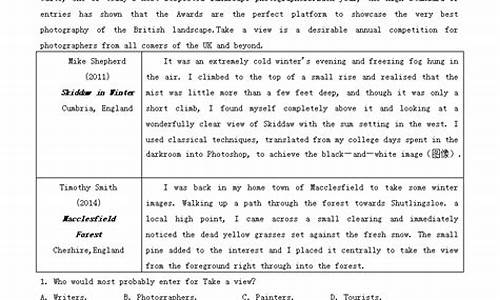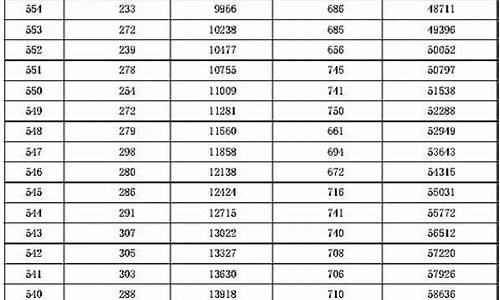您现在的位置是: 首页 > 教育新闻 教育新闻
英语语法高考占比_英语语法高考
tamoadmin 2024-05-20 人已围观
简介1.高考英语13个语法考点高考英语语法:英语双重所有格的用法 1、所谓双重所有格就是指将 -’s 所有格与 of 所有格结合起来一起使用:a friend of my father’s 我父亲的一位朋友 a photo of Mr Smith’s 史密斯先生的一张照片 2、双重所有格的使用场合:①当被修饰名词前有指示代词、疑问代词、不定代词或数词等限定词时,一般要用双重所有格: I don’t l
1.高考英语13个语法考点

高考英语语法:英语双重所有格的用法
1、所谓双重所有格就是指将 -’s 所有格与 of 所有格结合起来一起使用:
a friend of my father’s 我父亲的一位朋友
a photo of Mr Smith’s 史密斯先生的一张照片
2、双重所有格的使用场合:
①当被修饰名词前有指示代词、疑问代词、不定代词或数词等限定词时,一般要用双重所有格:
I don’t like that big nose of David’s. 我不喜欢大卫的那个大鼻子。
Which novel of Dickens’ are you referring to? 你谈的是狄更斯的哪部小说?
Some friends of my brother’s will come. 我兄弟的一些朋友要来。
注被双重所有格修饰名词前有指示代词时,通常带有一定的感情色彩(如赞赏、不满、厌恶等):
That little daughter of your cousin’s is really a dear. 你表哥的那个小女儿真是逗人爱。(表赞赏)
That daughter of your cousin’s is constantly complaining. 你表哥的那个女儿老是在报怨。(表厌恶)
另外,被双重所有格修饰的名词前可以用不定冠词,但通常不用定冠词:
可以说:a poem of Shelly’s, a novel of Dickens’
不能说:the poem of Shelly’s, the novel of Dickens’
②有时既可用双重所有格也可用 of 所有格,但含义稍有差别。比较:
a photo of Mary’s 玛丽收藏的一张照片
a photo of Mary 玛丽照的一张照片
a criticism of William’s 威廉提出的批评
a criticism of William 对威廉的批评
高考英语13个语法考点
高考考前语法填空和短文改错代词易错点查漏补缺
代词
1、作表语常用宾格,在独词句中用宾格。
a.—Who is knocking at the door?——It’s me
b. He is a student in this school. And me, too.
2、it 指无生命的事物、婴儿、以及who、someone等不名身份的人。
eg: a. —Who is outside? —It is me
b. Someone has entered the house. It must be a thief
c. The baby is very lowly. It was born half a year ago.
3、反身代词可用作①宾语②表语(表示“健康”的含义)③同位语(作主语同位语,可以放在主语后面,或后置; 如果作宾语同位语,则放在宾语后面)
eg: a. Mr Black can’t express himself in Chinese. b. I am not quite myself today.
c. She herself opened the door. She opened the door herself.
d. You’d better ask Mr Smith himself about it.
4、指示代词this, that用于电话用语中。
—Who’s that (speaking)?
—It/This is Tom (speaking)?
5、this/that 修饰adj/adv. 表示“这么”“那么”的含义,相当于so 。
a. Oh, the girl is not that foolish. b. I can only promise you this much.
c. We didn’t expect that the weather in Tongren was that hot.
6、it、that、those、one、the ones的指代区别。
1)it指上文提到的同一事物或整句话的内容。
a. “Do you want the watch?”“Yes , I want it.”
b. He warned his son not to play computer games again, but it didn’t help.
2)that常用来指代同名异物的不可数名词
a. The population of China is much larger than that of any other country in the world.
b. The weather in Kaili is much better than that in shanghai.
3)those或the ones 用来指代上文提到的复数名词。
a. Watches made in China are just as good as those/ the ones made in Switzerland.
b. The books are better than those you bought yesterday.
4) one指代同名异物的某个单数名词,如果特指就用the one.
a. I want to buy a Mp3. Do you need one?
b. Here are enough apples . Each of you can get one.
c. I don’t like this dictionary. I prefer the one on the shelf.
7、both、either、neither的用法
a. Both of them are right (主语)
Both the brothers/ Both of the brothers are at college.(定语)
b. Neither of the answers is / are correct.(主语)
Neither seat is taken .(定语)
c. You can take either of the dictionaries.(宾语)
Flowers are planted on either side of the street.(定语)
8、none、all 的用法
a. All has been done.(作主语,表示“所有事”谓动用单数)
All are present . (作主语,表示“所有人”谓动用复数)
b. None of the girls in our class like/likes football.
注意:在回答what/who 问句时,用nothing/nobody;而在回答how many/How much……问句时用none.
Who is in the classroom? Nobody. What is in your hand? Nothing.
How much money do you have? None.
9、every、each的使用
1)every只能修饰名词,而each既可修饰名词,也可作名词使用。
eg: every day、each classroom、each of the student
2)在单独作主语、同位语、宾语时只用each.
a. Here are enough glasses. Each of you can get one.
b. We each should listen to the teachers carefully.
3)every能表达“每隔”的含义,而each则不能。
every three days 每3天、每隔2天 every few years每隔几年
every other day /week/line每隔1天/1周/1行
4)every与one连用,可用of修饰( 要分开写)。
every one of us 我们中的每一人 each of us我们中的每一人
every one of the books 这些书中的每1本
each of the books这些书中的每1本
10、some与any
1)表示“一些”含义时,some用于肯定句中,any用于否定、疑问、条件句中,都可以修饰可数名词或不可数名词。
a. I have some questions to ask you.
b. Do you have any trouble in learning English? If any, do ask me for help.
注意:1)some表示“一些”时,可用于“征求意见”“提出建议”的疑问句中。
a.—Would you like to have some ice cream?
—No.
—How about some water?
—Yes, please.
2)some后接单数可数名词时表示“某一”的含义。相当于“a certain.”
some day 将来某一天 some kind of animals某一种动物
3)some 可以和数词连用,表示“大约”的含义。
The story took place some forty years ago.
4)any如果表示“任何”含义时,可以用于肯定句中。
Here are three novels. You may read any.
11、one……the other、another、other+复数名词、others、the other+复数名词、the others
1)当前提只有两个时,表达“一个,另一个”用one……the other,此时the other作名词用。
I have bought two books. One is a dictionary, the other is a story book.
2)当前提有3个或以上时,表达“另一个”用another或“a(n)+序数词( 序数词的选择要根据语境来)”表示。
Please show me another book.
I have stayed in Kaili for a week, but I still want to stay here for a second week.
注意:如果是“一段时间”或“一笔钱”时,可以用another。此时虽然是复数的形式,但它是单数含义。
a. We need another three days to finish the work.可以替换为:three more days three other days
b. Sorry, your money is not enough. You need to pay another 10 dollars
10 more dollars
10 other dollars
3)other(adj)+复数名词或others(n)表示除去一部分外剩余的某一部分,前面常有特征词some.
a. Some people are against you, but others/other people may agree with you.
b. I don’t like this shirt. Have you got any others?
4)the other(adj)+复数名词或the others(n)表示除去一部分外剩余的全部,一般都要有一定的范围。
There are 70 students in the class. Some are from the USA and the others/ the other students / the rest are from China.
12、little、a little、few、a few的使用
1)little“几乎没有”修饰不可数名词 There is little water in the desert
2)few“几乎没有”修饰可数名词的复数形式。Few people like him.
3)a little“一点,一些”,修饰不可数名词。 There is still a little soup in the bowl.
4)a few“一些,几个”修饰可数名词的复数形式,相当于some、several, a couple of
I bought a few books yesterday
13、many与 much的使用
1)much+不可数名词 much water/ information/ pleasure…etc
2)many+复数名词 = a good /great many+复数名词作主语,谓语动词用复数形式。
然而: many a(n)+单数可数名词,如many a student, 作主语,谓动用第三单形式。
14、疑问代词
What、which、who、whom、whose、how many/much、how soon、how often、how long、etc、
(1)、在句中作主语、宾语(含介词宾语)、表语且指sth.用what, 另外:表示“是。。。什么样子”也用what.
a. —What’s your name?—My name is Peter. b. —What is on your desk?
c. What’s the weather like today?
d. What does your father look like?
e. My hometown is not what it used to be 10 years ago.
(2)、在句中指人且作主语,用who;如果指人作宾语,可以用who/whom
a. Who’s in charge of your class?
b. Who/Whom did you meet yesterday?
(3)、指人且在句中作定语,用whose。注意相应的名词要紧跟whose。
a. Whose father is a teacher?
b. Whose bike did you lose yesterday?
(4)、当表示“哪一个/ 哪一些”含义时用which,相应的名词也要紧随其后
a. Which dictionary do you like?
b. Which students will be chosen to be volunteers?
(5)、提问数目时用how many(much),可数名词用how many,不可数名词用how much。注意相应的名词也要紧随其后,如果问的是“钱”或“某种程度”时,how much后常不接名词。
a. How many people are there in your class?
b. How much vegetable did you buy this morning?
c. How much did you spend on the house?
d. How much do you like the dictionary?
(6)、在将来时中表示在一段时间后“用介词in+时间”, 含义为:....之后。提问则用how soon(多久以后).
The road will be completed in two years.
How soon will the road be completed?
(7)、how often用来提问频率。
He went back home twice a month last year.
How often did he go home last year?
(8)、how long 用来提问“for+一段时间”通常指(1)到目前为止,且在现在完成时中。(2) 将要做某事长达一段时间。
They have been married for five years.→ How long have they been married?
I will stay in my college for 4 years. → How long will you stay in your college?
15、全部否定与部分否定
1)both/every/all与not连用表示部分否定。
Not every student is from the UK=Every student is not from the UK.
Both of them are not from Guiyang.= Not both of them are from Guiyang.
Not all of us study hard.= All of us don’t study hard.
2)either……not、any……not、neither、none、nobody、nothing、each……not都表示全部否定。
a. Either of the two brothers is not a student.=Neither of the two brothers is a student.
b. Any of them doesn’t like to dance. None of them likes/like to dance.
c. Nobody is absent.
d. Nothing does good to you. e. Each of the students doesn’t want to go with you.
高考英语语法知识点
一般过去时
①一般过去时的基本用法:表示过去的事情、动作或状态常与表示过去具体的时间状语连用(或有上下文语境暗示);用于表达过去的习惯;表示说话人原来没有料到、想到或希望的事通常用过去式。如:
I met her in the street yesterday.
I once saw the famous star here.
They never drank wine.
I thought the film would be interesting,but it isn’t.
②如果从句中有一个过去的时间状语,尽管从句中的动作先于主句发生,但从句中的谓语动词连用过去式。如:
③表示两个紧接着发生的动作,常由以下词语连接,用一般过去时。如:but, and, when, as soon as, immediately, the moment, the minute。
The moment she came in, she told me what had happened to her.
He bought a watch but lost it.
④常用一般过去时的句型:
Why didn’t you / I think of that?
I didn’t notice it.
I forgot to tell you I had been there with my brother before.
I didn’t recognize him.
高考英语知识要点
1.表示“大量、许多”
可数:number/many/dozen/a great number 不可数:a great deal/amount/much 都可以:plenty of/lot/quantity/mass
2.可以修饰形容词比较级:far/even/any/much/rather/a bit/a lot
3.lie躺-lay-lain-lying 撒谎-lied-lied-lying
Lay下蛋-laid-laid-laying
4.can表示能力,be able to表示经过努力,有时态变化
5.receive强调客观接收,accept强调主观接受
6.on account of因为,由于;account for说明原因解释
7.accuse sb of指控某人,sue指控
8.add to增加扩大,add up加起来,add up to总共总计
9.afford负担得起,抽得出时间
10.after以过去为起点,用于过去时态,in以将来为起点,用于将来时态









